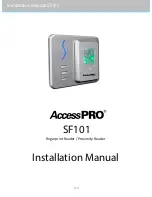
PCIE-1763AH/DH User Manual
2
1.1
Introduction
The PCIE-1763AH provides 16 solid-state relay (SSR) outputs and 16 isolated digital
inputs. The SSRs are classified to semiconductor relays which do not have moving
contact and differ from the conventional electro-mechanical relays in many ways.
They are superior to electro-mechanical relays in longer lifetime, higher operating
speed, less contact problems such as arcs, bounce, and noise. In addition, the zero-
crossing (synchronous) trigger effectively reduces inrushing current and electrical
noise during SSR turn on. Therefore, they are most suitable for applications which
need conducting high voltage (> 80 VAC) AC loads and frequent ON/OFF switching.
The PCIE-1763DH provides 16 photoMOS relay outputs and 16 isolated digital
inputs. The photoMOS relays are classified to semiconductor relays which do not
have moving contact and differ from the conventional electro-mechanical relays in
many ways. They are superior to electro-mechanical relays in longer lifetime, higher
operating speed, less contact problems such as arcs, bounce, noise, and smaller
size. Therefore, they are most suitable for applications which need conducting DC
low voltage load (< 60 V) and frequent ON/OFF switching.The isolated digital inputs
accept both dry and wet contact configurations. All channels have interrupt capability
and are equipped with programmable duration noise filters.
1.2
Features
16-ch solid-state relay (SSR) output with longer lifetime and higher operating
speed compared to electro-mechanical relays.
Zero-crossing (synchronous) trigger for reduced inrushing current and electrical
noise.
16-ch photoMOS relay outputs with longer lifetime and higher operating speed
compared to electro-mechanical relays.
Much less contact problems such as arcs, bounce, and noise.
Suitable for both AC and DC applications with frequent ON/OFF switching.
LEDs for output state indication.
16-ch isolated digital input (IDI) with wet contact configurations.
Interrupt capability for all IDI channels.
Programmable duration noise filter for all IDI channels.
Advantech PCIE-1763 card also offers the following main features:
Robust Protection
The PCIE-1763’s digital input channels feature robust isolation protection for indus-
trial, laboratory, and machine automation applications. The card is compatible with
voltages of up to 2,500 V
DC
, protecting the host system from accidental damage. If
connected to an external input source with surge protection, PCIE-1763 can offer up
to a maximum of 2,000 V
DC
electrostatic discharge (ESD) protection. Even under an
input voltage of 70 V
DC
, the PCIE-1763 card will still function correctly, but only for
short periods of time.
Wide Input Range
The PCIE-1763 supports a wide input voltage range of 10 to 30 V
DC
and is suitable
for most industrial applications with 12 V
DC
and 24 V
DC
input voltage.
Summary of Contents for PCIE-1763AH
Page 6: ...PCIE 1763AH DH User Manual vi...
Page 7: ...Chapter 1 1 Overview...
Page 11: ...Chapter 2 2 Installation...
Page 16: ...PCIE 1763AH DH User Manual 10...
Page 17: ...Chapter 3 3 Signal Connections...
Page 20: ...PCIE 1763AH DH User Manual 14...
Page 21: ...Appendix A A Specifications...
Page 24: ...PCIE 1763AH DH User Manual 18...
Page 25: ...Appendix B B Block Diagram...
Page 26: ...PCIE 1763AH DH User Manual 20 B 1 Block Diagram Appendix A...
Page 27: ...21 PCIE 1763AH DH User Manual Appendix B Block Diagram...









































